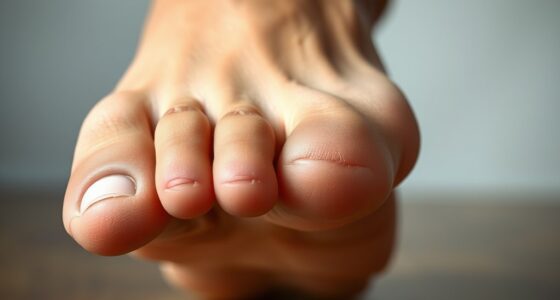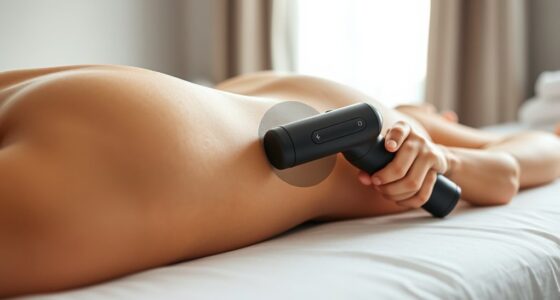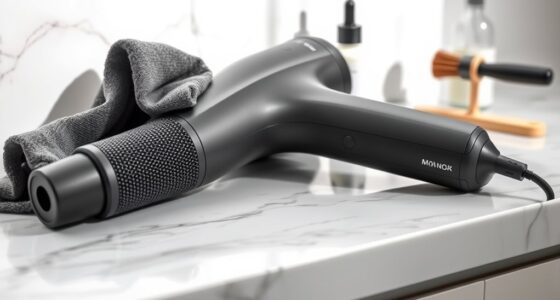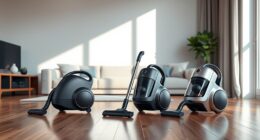Using a massage gun during injury rehab works best when you work closely with a physical therapist. They can personalize treatment, guiding you on proper technique, pressure, and targeted areas to avoid setbacks. This collaboration ensures safe, effective use and helps monitor your progress. Combining massage gun therapy with stretching, strengthening, and manual therapy can accelerate recovery. Keep exploring, and you’ll discover how to optimize your rehab journey for a faster return to peak performance.
Key Takeaways
- Collaborate with a physical therapist to personalize massage gun use based on injury history and muscle weaknesses.
- Receive guidance on proper techniques, pressure, and duration to ensure safe and effective treatment.
- Use massage guns alongside stretching and strengthening exercises for comprehensive injury rehabilitation.
- A physical therapist monitors progress, adjusts treatment plans, and prevents overuse or further injury.
- Track recovery progress with tools like journals or apps to optimize massage gun therapy and overall rehab outcomes.

Massage guns have become a popular tool for injury rehabilitation because they help speed up recovery and reduce muscle soreness. When you’re working to get back to your peak, integrating a massage gun into your routine can make a noticeable difference. These devices stimulate blood flow and loosen tight muscles, which is vital for improving your sports performance and accelerating muscle recovery. But to get the most out of this technology, it’s best to work with a physical therapist who can tailor treatments specifically to your needs.
Your physical therapist understands your injury history, specific muscle weaknesses, and movement patterns. They can guide you on how to use the massage gun safely and effectively, guaranteeing you target the right areas without risking further injury. For example, they might recommend using the device on particular muscle groups that need extra attention, such as those prone to tightness or strain from your sport. This targeted approach enhances your recovery process and helps restore ideal muscle function faster.
A physical therapist guides safe, targeted massage gun use to optimize recovery and prevent injury.
Incorporating massage guns into your injury rehab under professional guidance can also support your sports performance. When your muscles recover well and are less sore, you can train more intensely and with better technique. The improved muscle recovery process means you won’t experience as much downtime due to soreness or fatigue, keeping you consistent in your training. Your physical therapist might suggest specific massage gun routines to complement stretching, strengthening exercises, or manual therapy, creating an all-encompassing plan that promotes faster healing and better athletic output.
Moreover, working with a therapist ensures that you’re not overusing the device or applying it improperly. Misuse can lead to bruising or irritation, which could slow down your progress. Your therapist can teach you proper techniques, including pressure levels and duration, so you get the maximum benefit without risking setbacks. They can also monitor your progress and modify your treatment plan as your muscles heal and your performance improves.
Additionally, understanding how to properly track your recovery progress can lead to more effective results. Using keto diet tracking apps or journals for monitoring your routines and symptoms can help identify what techniques or treatments are most effective for your specific injury. Ultimately, combining the benefits of massage guns with professional guidance enhances your injury rehab process. This partnership helps you recover more efficiently, regain strength, and return to your sport with confidence. By focusing on targeted muscle recovery and strategic use of technology, you’re setting yourself up for a quicker, safer return to peak performance. Your physical therapist plays an essential role in making sure you use your massage gun effectively, turning it into a powerful tool for injury rehab and sports enhancement.
Frequently Asked Questions
Can Massage Guns Replace Physical Therapy Sessions Entirely?
You might wonder if massage guns can fully replace physical therapy sessions, but they can’t. Self-massage techniques with a gun can help with muscle tension, yet they lack the tailored guidance and progress tracking a therapist provides. Collaborating with a physical therapist ensures proper recovery and injury prevention. So, while massage guns are useful tools, they should complement, not substitute, professional therapy for effective injury rehab.
Are There Any Risks Using Massage Guns During Injury Recovery?
Some might think using massage guns during injury recovery is risk-free, but they can cause muscle soreness or disrupt circulatory effects if misused. You should be cautious, especially if your injury is recent or severe. Using a massage gun improperly could worsen inflammation or delay healing. Always follow your physical therapist’s guidelines and avoid aggressive use to guarantee safe recovery and prevent setbacks.
How Do I Choose the Right Massage Gun for Rehab?
When choosing the right massage gun for rehab, focus on features that target muscle tension and provide pain relief. You want one with adjustable speed settings and multiple attachments to customize your therapy. Consider the gun’s amplitude and battery life to guarantee consistent use. Always consult your physical therapist to match the device to your specific injury, avoiding overuse and ensuring safe, effective recovery.
How Often Should I Use a Massage Gun During Injury Rehab?
Sure, because who doesn’t love turning into a human drum to beat muscle soreness? During rehab, you should use your massage gun as recommended by your therapist, usually a few times daily. It helps improve circulation and eases soreness—just don’t overdo it. Too much can cause irritation. Listen to your body, and follow their guidance to balance muscle recovery with safe use.
Can Massage Guns Help Prevent Future Injuries?
You might wonder if massage guns can help prevent future injuries. They promote muscle relaxation and improve blood circulation, which are key to maintaining healthy muscles and preventing strain. Regular use can help identify tight areas early and keep your muscles supple. However, it’s essential to use them correctly and alongside proper training and stretching, ideally under guidance, to effectively reduce injury risk and support your overall muscle health.
Conclusion
Incorporating a massage gun into your injury rehab is like adding a trusted compass to navigate your recovery journey. When used under the guidance of a physical therapist, it becomes a powerful tool to ease pain and promote healing. Remember, it’s not a shortcut but a steady hand guiding you back to strength. Trust the process, stay patient, and let this innovative device be a gentle tide that moves you forward.









